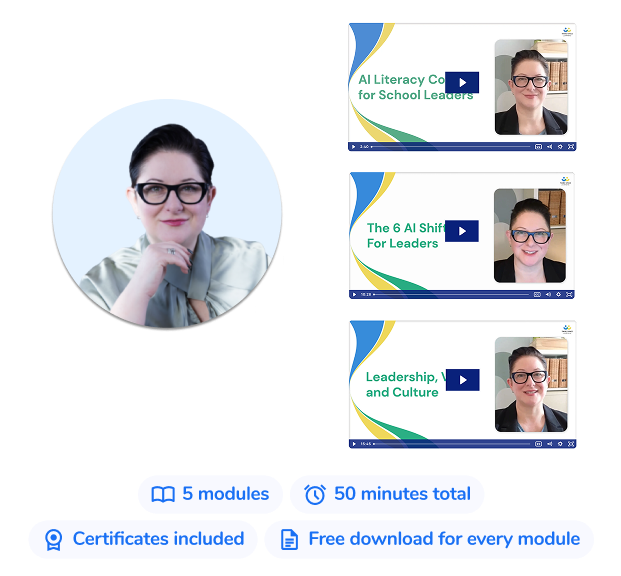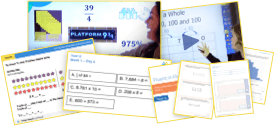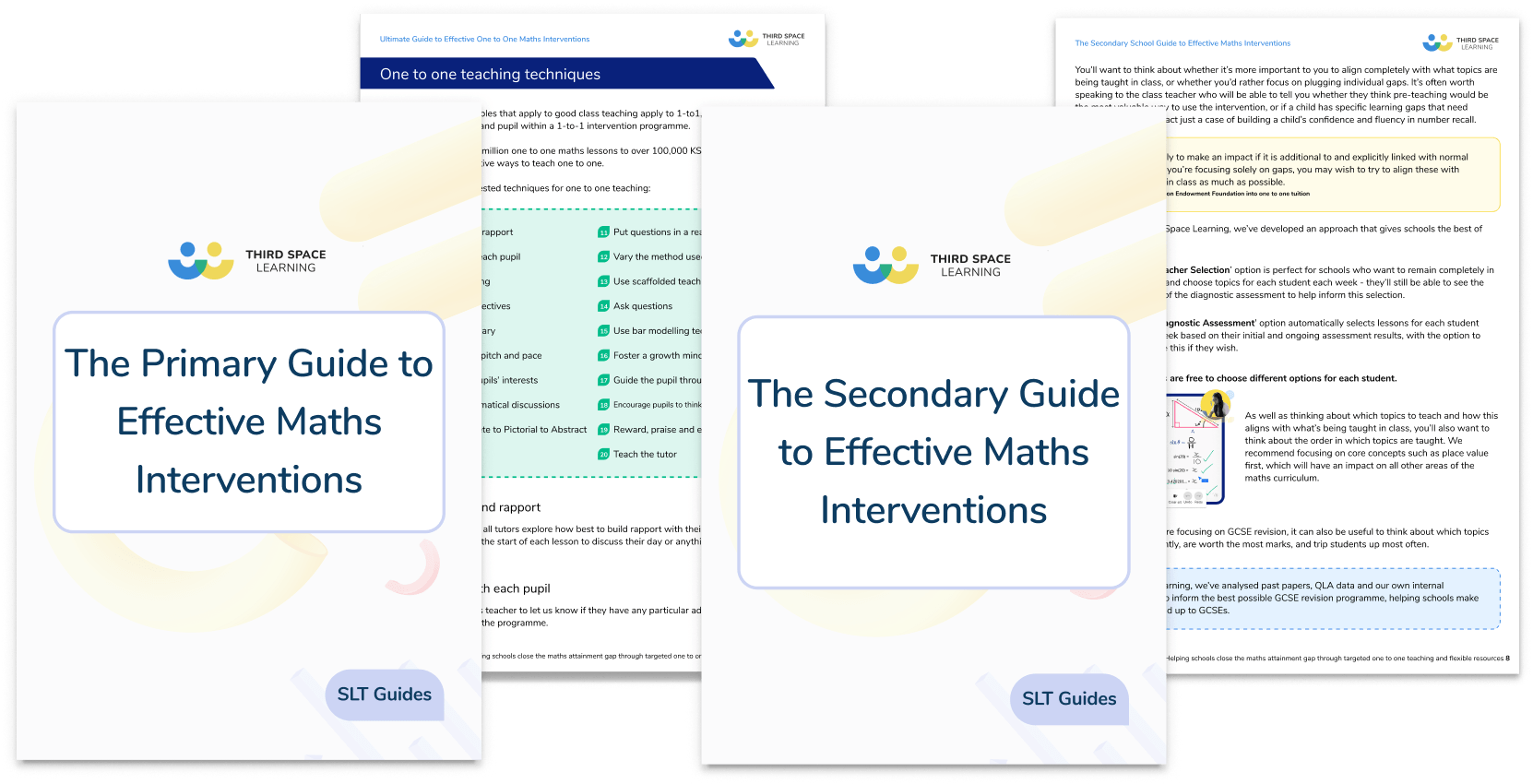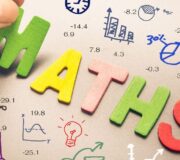8 Ways to Close the Attainment Gap: EEF Maths Report
Here we provide a summary of the 8 key findings of the EEF Report ‘Improving Mathematics in Key Stages 2 & 3’ for all Maths Coordinators and Headteachers together with recommended free resources and next steps that you can take to embed best practices in your school.
The EEF Maths report looks across all the Education Endowment Foundation research on why primary schools must continue to focus on closing the attainment gap in maths and the 8 key recommendations from the research on how to do this.
We encourage you to read and assimilate the entire EEF report. However, as it’s over 10,000 words long you may want to signpost your team to this summary blog post in the first instance to help you consider together any improvements to your own primary maths strategy.
The Ultimate Guide to Effective Maths Interventions
Find out how to plan, manage, and teach 1-to-1 Maths interventions to raise attainment in your students. Includes a 20 point checklist for improvement.
Download Free Now!What the attainment gap in maths looks like
Over half of the pupils eligible for free school meals did not achieve expected levels in maths. EEF’s report found ‘one in two young people from low-income households who are currently denied access to secure and well-paid careers, and to further study’.
To help schools break ‘the link between family income and educational attainment’ (the attainment gap), there are 8 key recommendations for school leaders:
- Use assessment to build on pupils’ existing knowledge and understanding
- Use manipulatives and representations
- Teach strategies for solving problems
- Enable pupils to develop a rich network of mathematical knowledge
- Develop pupils’ independence and motivation
- Use tasks and resources to challenge and support pupils’ mathematics
- Use structured interventions to provide additional support
- Support pupils to make a successful transition between Primary and Secondary school
Read on for more detail on each recommendation on how to improve maths teaching at KS2 and KS3 and how to work towards closing the attainment gap.
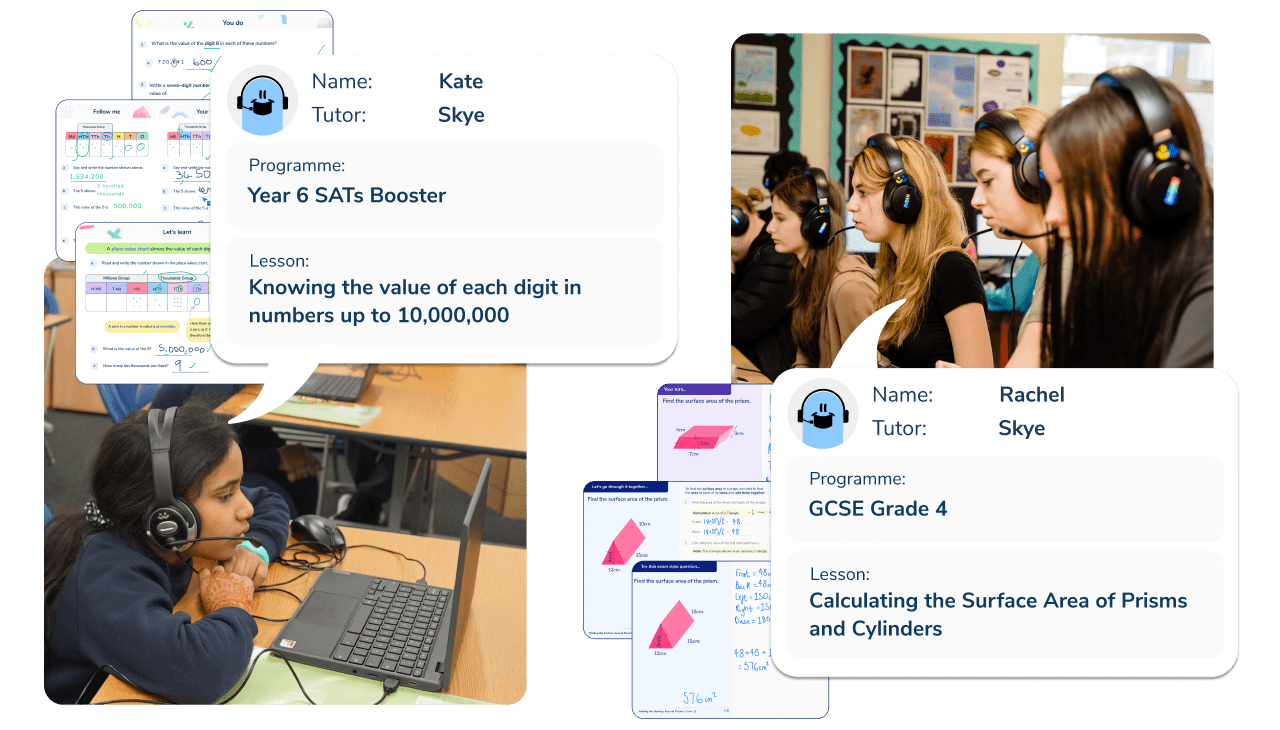
Meet Skye, the voice-based AI tutor making maths success possible for every student.
Built by teachers and maths experts, Skye uses the same pedagogy, curriculum and lesson structure as our traditional tutoring.
But, with more flexibility and a lower cost, schools can scale online maths tutoring to support every student who needs it.
Watch Skye in actionEEF Recommendation 1: Use assessment to build on pupils’ existing knowledge and understanding in maths
The EEF report outlines how, when used properly, assessment is not just for tracking pupils’ learning (see more on the myth of looking for expected progress here).
Assessment can – and should – also be used diagnostically; providing teachers with ‘up-to-date and accurate information about what pupils do and do not know’.
When used this way, assessment (like this set of 4 Diagnostic Year 6 Maths Quizzes) is at its most effective: informing planning, addressing weaknesses, and focusing teaching upon the ‘next steps [a pupil needs] to make progress’.
Moreover, the report demonstrates how responses to assessment are equally crucial to the assessment itself. Stating that feedback, oral or written, is ‘generally found to have large effects on learning’.
However, it also notes that schools should beware of creating ‘onerous marking policies and a heavy teacher workload’.
Find out about effective marking here.
The report outlines these six points as the ‘characteristics of effective feedback’:
- Be specific, accurate, and clear in your feedback
- Give feedback sparingly so that it is meaningful
- Compare what a pupil is doing right now with what they have done wrong before
- Encourage and support further effort
- Provide guidance to pupils on how to respond to teachers’ comments
- Provide specific guidance on how to improve
EEF Recommendation 2: Use manipulatives and representations at all Key Stages in Maths
Next up in the EEF Maths report’s spotlight is the use of manipulatives and representations. Specifically, ‘how they are used’ and what effective use looks like.
The report identifies a need for a ‘clear rationale’ for the use of a manipulative or representation when teaching a method.
This rationale, generally, should be to model the use of manipulatives in a way that reveals the underpinning mathematical structures of a concept. Ultimately, providing pupils with a toolkit to independently approach their mathematical work.
The EEF report also provides a basic 5-point framework for what ‘effective’ use of manipulatives and representations might look like:
- Ensuring that there is a clear rationale for using manipulatives/representations to teach a specific concept
- Enabling pupils to understand the links between manipulatives and the mathematical ideas they represent
- Avoiding pupils become reliant on manipulatives to complete a task or question (instead, they should be a stepping stone)
- Using manipulatives as a ‘scaffold’ which can be removed once independence is achieved
- Employing manipulatives/representations to support pupils of all ages
It also provides a “worked example” of what effective use looks like in the image below:
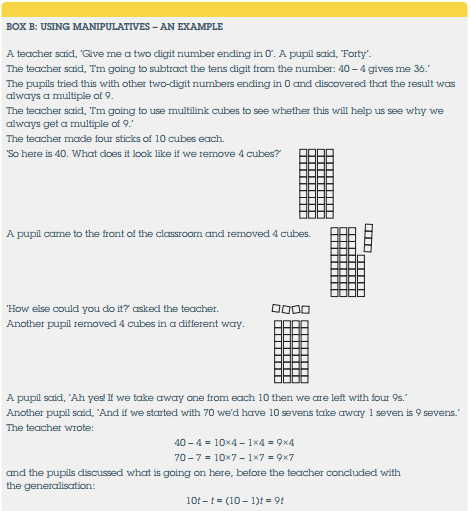
Before summarising, there is ‘promising evidence that comparison and discussion of different representations can help pupils develop conceptual understanding’, but that ‘using too many representations at one time may cause confusion and hinder learning.
You can download our list of the top 15 concrete resources for free in our Ultimate Guide to Maths Manipulatives (some as little as £1).
Or take a look at how to use one of the most popular methods of representation in Maths; the bar model.
EEF Recommendation 3: Teach pupils strategies for solving problems
Problem solving, as we all know, is a huge part of the KS2 SATs, as well as an important part of every-day life.
To aid pupils struggling with problem solving skills, the EEF maths report argues that pupils need a range of problem solving strategies. Enabling them to ‘make sense of unfamiliar situations and tackle them intelligently’.
Describing a problem solving strategy as an ‘approach to solving a problem [that] can be applied to solving a variety of different problems’, the report outlines 7 things teachers should consider when developing problem solving skills:
- Select genuine problem-solving tasks that pupils do not have well-rehearsed, ready-made methods to solve (Third Space Learning has a daily calendar-based problem solving activities that fit the bill for this one)
- Consider organising teaching so that problems with similar structures and different contexts are presented together, and, likewise, that problems with the same context but different structures are presented together
- Teach pupils to use and compare different approaches to the same problem
- Teach pupils to interrogate and use their existing mathematical knowledge to solve problems
- Encourage pupils to use visual representations
- Use worked examples to enable pupils to analyse the use of different strategies
- Require pupils to monitor, reflect on, and communicate their reasoning and choice of strategy
Many of the resources in our maths hub focus on problem solving. We also provide advice on the different types of maths problems available and how to teach children a variety of problem solving techniques in maths. This article in particular about using the bar model to solve Year 6 word problems breaks it down step by step.
EEF Recommendation 4: Enable pupils to develop a rich network of mathematical knowledge
Beyond teaching individual topics well; point four of the report emphasises a need for pupils to be able to make connections between ‘different mathematical facts, procedures, and concepts to create a rich network’ of understanding.
The EEF report provides six key areas of teaching that build fluency, talk for maths and help pupils develop connections between a range of mathematical topics.
- Ensure pupils develop fluent recall of number facts – the report highlights this as ‘important for success’ in all mathematics. Without these crucial building blocks to mathematical understanding, pupils will struggle to understand concepts later down the line
- Teach pupils to understand procedures – another cornerstone of good Maths learning. Without ‘ensuring appropriate time is spent on developing understanding’, pupils will not be able to ‘reconstruct steps in a procedure that they may have forgotten’
- Teach pupils to choose between mathematical strategies – the report details how pupils should be helped to compare and contrast different methods when approaching a problem
- Build on pupils’ informal understanding of multiplicative reasoning to introduce procedures – with so much time spent teaching formal methods of multiplication and division, informal methods can get left behind. The report brings to light evidence suggesting that ‘delaying the teaching of formal methods to focus on developing multiplicative reasoning is beneficial’
- Teach pupils that fractions and decimals extend the number system beyond whole numbers – the key takeaway here is to remember that fractions (and decimals) are simply numbers that can be represented on a number line. Reminding pupils of this can ‘address common misconceptions’ such as adding numerators and denominators to add a fraction
- Teach pupils to recognise and use mathematical structure – the final point demonstrates the need to ‘support pupils to use language that reflects mathematical structure’ in order to help make connections between ‘problems, solution strategies, and representations that may […] appear different’
EEF Recommendation 5: Develop pupils’ independence and motivation to improve their maths
Maths can be really hard, though it might be hard for some of us to admit. It requires the ability to persevere, re-consider, and be metacognitive (to think about one’s own thinking).
These higher order reasoning skills don’t just happen naturally. Instead, we must teach, model, encourage and then praise them.
The EEF Maths report suggests we ‘develop metacognition through structured reflection upon learning’, until pupils naturally and independently become self-reflective, ‘without needing support from the teacher or their peers. It describes how teachers can do this by ‘encouraging self-explanation’ to the teacher and class.
It also points out 3 challenges and possibly remedies you’ll want to bear in mind when encouraging metacognition in pupils:
- Ensure metacognition does not ‘detract from concentration on the mathematical task itself’
- Provide ample time to ‘imitate, internalise and independently apply strategies’ (metacognition takes time!)
- Discussion and dialogue are hugely ‘useful tools for developing metacognition’, but this must be modelled properly to pupils first (e.g. – ‘what to do as a listener’)
Finally, on the point of maths being difficult, we must praise pupils for their effort and motivate them effectively.
As the report states, ‘the development of self-regulation and metacognition […] requires deliberate and sustained effort’.
Without modelling a positive attitude (what some may call a ‘growth mindset’) and rewarding hard work, pupils will likely give up. The proof is in a statistic from the report, ‘ In a recent survey, the proportion of pupils who reported that they do not like learning maths was 17% at Year 5 and 48% at Year 9’.
Read more on how to instil determination, resilience and a positive outlook in your Maths pupils in our blog: How to Get Growth Mindset Right in Primary Schools.
EEF Recommendation 6: Use tasks and resources to challenge and support pupils’ mathematics
As the report states, ‘Tasks are critical to the learning of mathematics because the tasks used in the classroom largely define what happens there.’
Yet, research in the report suggests that actually, how you implement the task is more important than the task itself.
As such, deploying a task effectively is the best way for it to have a positive effect on learning. Highlighting the ‘considerable level of skill’ needed to do this well, the report targets effective task deployment as a ‘priority for CPD’.
It also details 6 ways you can frame a task for maximum impact:
- Select your tasks based on your ‘assessment of pupils’ strengths and weaknesses’ (our Set of 3 Year 5 Diagnostic Quizzes could help here)
- Use tasks to address pupils’ misconceptions
- Provide tasks that ‘demonstrate examples and non-examples of concepts’ (seek out misconceptions)
- Consider tasks that ‘discuss and compare different solution approaches’
- Use tasks full of ‘opportunities for pupils to investigate mathematical structure and make generalisations’
- Use tasks that ‘build conceptual knowledge in tandem with procedural knowledge’
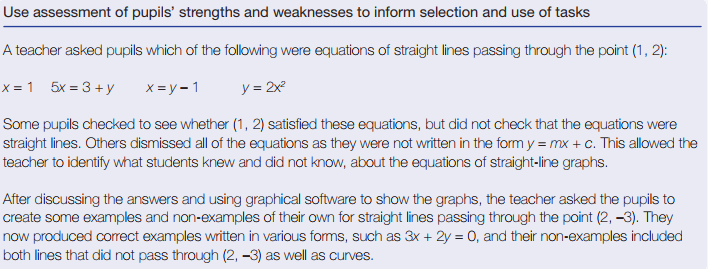
One of the best ways to support all pupils in your class is to aim for low threshold high ceiling tasks – download this Mixed Ability Maths Resource which has tasks such as the ‘Rice and Chessboard Game’ which designed with this approach in mind)
EEF Recommendation 7: Use structured maths interventions to provide additional support
The report’s penultimate point takes into account additional support for pupils.
Though, as the report rightly points out, schools should always focus on improving core provision for all pupils (therefore reducing the need for interventions), some intervention will always be required.
Drawing on guidance from an EEF review of maths interventions, the report details 8 elements of great catch-up interventions.
As a key provider of maths interventions in primary schools, we were pleased to see that many of the principles and strategies that we see working for our pupils are also proven to be effective on an even greater scale across multiple research evaluations.
1. ‘Interventions should happen early’
Starting interventions late breeds SATs pressure, and won’t provide the best results.
2. Interventions should ‘be informed by the evidence-based regarding effective teaching’
Intervention teaching should be as high quality as whole-class teaching. They should target the pupils who need great teaching the most. Read here for help with this: 20 Maths Interventions Strategies That Guarantee Progress for Any Pupils
3. ‘Interventions should include explicit and systematic teaching’
Third Space Learning’s team of maths experts has carefully designed and sequenced our maths tutoring programmes and diagnostic assessments to ensure maximum progress for each pupil. Lessons are personalised by sequencing them to cover the concepts pupils struggle with most.
4. Effective implementation is essential to success
Interventions need careful planning and strategic use of school resources: ‘the best-designed programme will not work if teaching staff are unavailable, excessively overburdened, or not adequately trained to deliver the programme’
5. Connections between intervention learning and whole-class learning must be frequently, and explicitly made
Teachers have the option of complete control over interventions. Children sit a diagnostic assessment to identify their gaps in maths. However, the class teacher is always free to request an alternative lesson that better fits the whole class teaching.
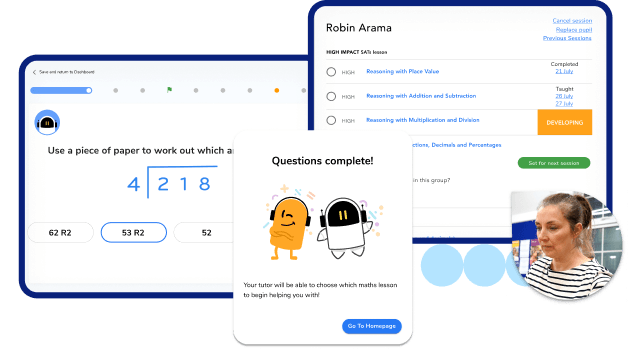
6. ‘Intervention should motivate pupils’
Third Space Learning’s AI maths tutor, Skye, is designed to create a positive and effective learning environment where pupils feel comfortable and engaged. The program provides one-to-one, personalised, and scaffolded lessons that actively address a pupil’s specific learning gaps. An initial diagnostic assessment helps identify a pupil’s baseline knowledge, and ongoing formative and summative assessments check for understanding and track progress over time.
Unlike other AI tutoring programmes, Skye uses a voice-based, conversational approach that encourages pupils to explain their mathematical thinking aloud. This dialogue-driven method is crucial for deepening understanding and identifying misconceptions. The conversational style mimics the natural back-and-forth of human interaction, which helps build confidence and reduces anxiety.
7. Always pay ‘careful attention’ to what a pupil might miss in class
Ideally, interventions will take place outside of lesson time. However, if lessons are missed, it is important to keep track of what pupils have missed in class and catch up where possible.
8. ‘Avoid intervention fatigue […] interventions do not need to be time-consuming, or intensive, to be effective’
One-to-one intervention sessions should be completed in short bursts to maximise pupil attention, engagement and progress. Third Space Learning interventions are 45 minutes long to help reduce intervention fatigue. 15 minutes is recommended at the end of sessions to complete post-session questions to reflect on the content covered.
Read more: How To Create A Comprehensive And Effective Pupil Premium Strategy
EEF Recommendation 8: Support pupils to make a successful transition between primary and secondary school maths
Finally, the EEF Maths report tunes in on the ‘dip in mathematical attainment and attitudes towards maths as children move from primary to secondary school in England’. Stating that schools need to pay acute attention to ensuring an effective transition and addressing this dip.
Though there is ‘little evidence concerning the effectiveness’ of specific strategies, the report details five questions school leaders should consider:
- Are primary and secondary schools developing a shared understanding of curriculum teaching and learning?
- How are primary schools ensuring that pupils leave with secure mathematical knowledge and understanding?
- When pupils arrive in Year 7, are secondary teachers attaining a good understanding of their strengths and weaknesses?
- How are secondary schools providing structured intervention support for Year 7 pupils?
- How are pupils allocated to maths classes when they enter Year 7?
The EEF Maths report provides much to think about! But the best way to close the attainment gap is to start with the SLT and make it a whole school improvement focus.
Schools need to continuously consider and reconsider the ways Maths is taught to ensure any pupil – regardless of background – has access to the best possible Maths education we can provide.
DO YOU HAVE STUDENTS WHO NEED MORE SUPPORT IN MATHS?
Skye – our AI maths tutor built by teachers – gives students personalised one-to-one lessons that address learning gaps and build confidence.
Since 2013 we’ve taught over 2 million hours of maths lessons to more than 170,000 students to help them become fluent, able mathematicians.
Explore our AI maths tutoring or find out about one to one tuition for your school.
